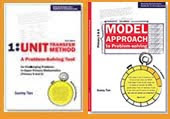Mastering Heuristics Series
Mathematical Strategies Made Simple
At last, a guidebook that delivers!
The
Mastering Heuristics Series is the brainchild of Sunny Tan, Principle Trainer at Maths Heuristics.
The
Mastering Heuristics Series captures Sunny’s simple, systematic yet strong techniques in understanding and applying Mathematical Heuristics. Edited by a strategic marketing communications professional cum parent who understands readers’ psyche and the time crunch parents face, the Mastering Heuristics Series is designed to be highly comprehensive.
Most Mathematics guidebooks provide only answers or, at most, brief workings. Without illustrating each step involved in the workings, readers end up having to figure out for themselves how the author got from one step to another. The
Mastering Heuristics Series offers two perspectives:
1. Concepts in action
– to show how easy and efficient Mathematical Heuristics are in solving challenging mathematical questions.
2. Concepts being applied
– to systematically show every step involved in applying each Mathematical Heuristics concept. Easy-to-follow step-by-step instructions make the
Mastering Heuristics Series the ultimate practical guide for parents.
The
Mastering Heuristics Series consists of four books. The first one, now available, covers six concepts – Before and After, Excess and Shortage, Repeated Identity, Equal, Two Variables, and Ratio and Proportion – under the Unit Transfer Method.
Since its release in the market in January 2009, the book has already garnered coverage by renowned parenting media – ParentsWorld (January 2009) and Wawa Magazine (March 2009) – as well as raving reviews by academia and parents.
Impetus for the School and the Series
While a teacher with Singapore’s Ministry of Education, Sunny observed how the current primary school Mathematics syllabus – different from what today’s parents and teachers were raised on – left many stumped. Mathematical Heuristics has been directly incorporated into the Mathematics syllabus. Teachers are not specifically trained to teach Mathematical Heuristics. Worse still, not neatly self-contained makes Mathematical Heuristics difficult to single out, learn and teach.
Consequently, many parents depend on tuition agencies or private tutors for their children’s Mathematics performance, not realising that most tutors were also raised on the same Mathematics syllabus as themselves, that is sans Mathematical Heuristics.
The more hands-on parents rely on Mathematics syllabus guidebooks to equip themselves to personally guide their children. However, there are no books on the market that specifically teaches Mathematical Heuristics. Where a guidebook comes close to it, its title merely allude to Mathematical strategies (not Mathematical Heuristics), making such books difficult to identify. Once acquired, parents often find themselves second guessing the author’s explanations, and how the author got from one step to another.
With the aim of closing this gap, Sunny emerged with techniques that simplified the application of Mathematical Heuristics. With that as a spring board, Sunny established the mathsHeuristics Programme, and now the
Mastering Heuristics Series in 2009. Both Programme and Series are available through Maths Heuristics.
1.
mathsHeuristics Programme
– Directly teaches primary students.
– Since its establishment, the Programme has transformed the Mathematics confidence level and performance of numerous students, including a CHIJ P6 student to went from scoring 52% in SA1 to 99% in the Preliminary exam, to A* in the 2008 PSLE – all within just 20 weeks.
2.
Mastering Heuristics Series
– Indirectly teaches primary students via parents.
– Backed by mathsHeuristics Programme’s proven track record, Sunny has authored this series of guidebooks based on the Programme’s techniques.
While the
Mastering Heuristics Series complements the mathsHeuristics Programme – by keeping parents informed of what their children are learning in the Programme, allowing parents to further support their children in the latter’s Mathematics homework – the Series is also comprehensive enough to be a standalone guide for parents who desire a bigger role in their children’s Mathematics education.
Distribution
Mastering Heuristics Series is available in the US and locally through Maths Heuristics (S) Private Limited. Orders may be placed online (at www.mathsheuristics.com) for home delivery, or in person (at 157A Goldhill Centre, Thomson Road, Singapore 307610) for self-collection.
Media Enquiries
Author / Publisher:
Maths Heuristics (S) Private Limited
Sunny Tan
Principle Trainer
Email:
sunny@mathsheuristics.com
Editor / PR Agency:
RE: TEAM
Karen Ralls-Tan
Managing Partner
Mobile: (65) 9787 3081
Email:
karen@reteamweb.com
Order Enquiries
Publisher:
Maths Heuristics (S) Private Limited
Christine Tham
Manager
Tel: (65) 6893 5593 (10am – 7pm, Tues to Sun)
Email: admin@mathsheuristics.com
















